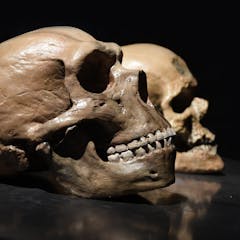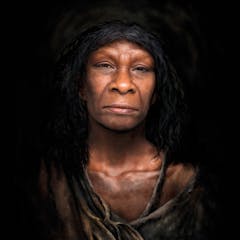
Articles on Human evolution
Displaying 21 - 40 of 194 articles

Contrary to the idea that apes evolved their upright posture to reach for fruit in the forest canopy, the earliest known ape with this stature, Morotopithecus, lived in more open grassy environments.

For more than a century, scientists have been puzzled by the set of shared changes that happen to many animals when they are domesticated.

The findings suggest we weren’t the first advanced carnivore among the hominins, as has been previously assumed.

Using a new equation based on today’s primates, scientists can take a few molar teeth from an extinct fossil species and reconstruct exactly how fast their offspring grew during gestation.

Africa’s large mammal heritage has formed a deep cultural legacy for all of humankind.

If we go far enough back in time, we all share an ancestor. And some of the features found in our bones and bodies today are a testament to that.

The way human brains develop is special – but not quite as special as you’d like to think, if we consider Neanderthals as well.

Rituals have been around for hundreds of thousands of years – but are they still useful today?

The human Y chromosome could disappear over time, putting our species in jeopardy. But some rodents have managed just fine without it – and we now know how.

It’s hard to imagine the world without Homo sapiens. But it’s unlikely we would be here if it wasn’t for a chance asteroid collision.

New genetic research shows humans’ famed ability to adapt our behaviour and develop new tools and techniques has not always been enough to survive when times have grown tough.

The findings come from placoderm fish fossils found in Western Australia’s Kimberley region. This extinct order of fish represents some of our earliest jawed ancestors.

As early modern humans spread across the globe, their gut microbes genetically changed with them. Understanding the origins of gut microbes could improve understanding of their role in human health.

Here’s what we can learn from our closest extinct relatives.

Cutting-edge analysis of fossil ape teeth reveals ancient seasonal change in Africa, long before human ancestors appeared. The method will be crucial for the future study of early hominins.

A language scientist explains that talking was never invented but has evolved over hundreds of thousands of years.

Reproduction is at the very heart of evolution. So why has celibacy persisted for so long?

Around 200,000 years ago, people were living who were as intelligent as us.

Human brains seem to be wired differently to those of chimps or macaques.

New research sheds light on why predators don’t evolve to become so aggressive that they eat all their prey – and then go extinct themselves.
